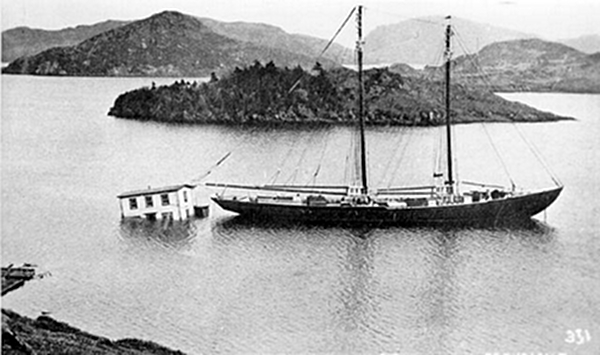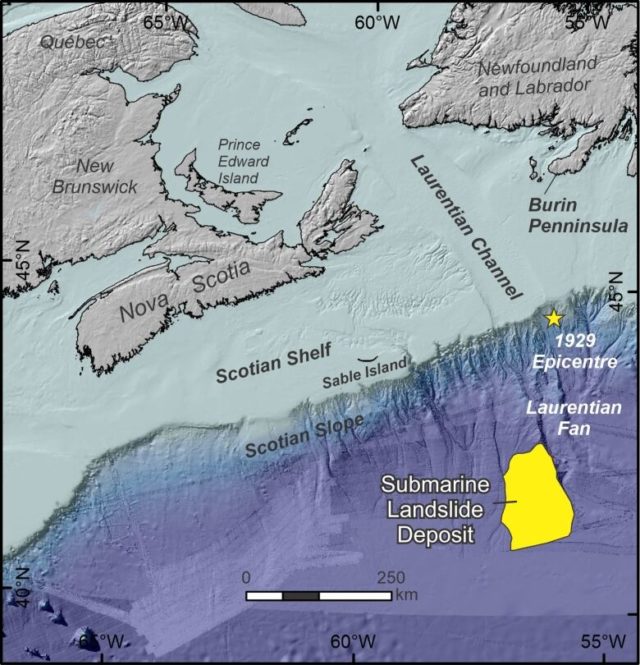18 November 2019
90 years after the 1929 Grand Banks earthquake: the hazards of submarine landslides on the western North Atlantic passive margin
Posted by Dave Petley
90 years after the 1929 Grand Banks earthquake: the hazards of submarine landslides on the western North Atlantic passive margin
On 18 November 1929 (90 years ago today) the Mw=7.2 Grand Banks earthquake triggered a submarine landslide off the coast of Newfoundland, which in turn generated a significant tsunami. Whilst the shaking damage was limited, the tsunami struck the Burin Peninsula in Newfoundland, Canada, killing 28 people:-

The aftermath of the 1929 Grand Banks Earthquake. This image shows The home of Steven Henry Isaacs of Port au Bras, which was towed back to shore after being swept out to sea by the tsunami and anchored to the fishing schooner Marian Belle Wolfe. Image via Natural Resources Canada.
.
Considerable work has been undertaken on that particular event since the disaster. It is thought that the earthquake triggered a submarine landslide with a volume of about 200 cubic kilometres, which in turn triggered the tsunami. However, the frequency of such events has been unclear until now.
Over the last few years there has been a dramatic improvement in the understanding of the hazards associated with submarine landslides, and the tsunamis that they can generate, on the margins of ocean basins, driven by deep ocean exploration. Indeed, even this weekend The Daily Express carried an article featuring the work (inevitably in a sensational style) of David Tappin from the British Geological Survey, explaining that tsunamis generated by submarine landslides may be more common on the coasts of the UK than had been understood previously.
In a new, very timely, paper published in the journal Geology (Normandeau et al. 2019), and available Open Access, report on the results of mapping with multibeam bathymetry, supported with the analysis of cores, off the coast of eastern Canada. This map shows the location of this work:-

The location of the landslide deposit, and the epicentre of the 1929 Grand Banks earthquake. Image from Natural Resources Canada, via CBC.
.
The researcher found extensive turbidite deposits, which they interpret as having been generated by submarine landslides similar to the 1929 Grand Banks earthquake event, more than 200 km from the coast and at about 4000 metres water depth. Analysis of these deposits suggests that they were formed in a series of landslides, representing four events over the last 4,000 years, with a total volume in the range of 300-400 cubic kilometres.
This study indicates that large submarine landslides may be more common on this section of the ocean basin than had been previously considered. The implications of this are not entirely clear without further research, as Normandeau et al. 2019) highlight:
“Although these landslide events occurred far from the coast, there are considerations for impacts to seabed infrastructure. Three submarine cables cross the Laurentian Fan region, all located on the large Laurentian Fan levee landslide described here. Additionally, the Canadian Atlantic margin is an area of active oil and gas exploration, with recent exploration wells drilled in water depths >2000 m and a potential for deepwater oil production. The tsunamigenic potential of these newly identified landslides is unknown, but the potential threat to coastal communities of eastern North America should not be discounted. A reevaluation of submarine-landslide risk across the western North Atlantic margin is recommended, and would require more systematic seafloor mapping, analysis of the distal record of large events, targeted slope stability analysis, and numerical modeling of landslide tsunamigenic potential.”
This is an excellent study, casting further light on these huge, potentially hazardous landslides. It is clear that they need to be investigated in more detail.
Reference
Alexandre Normandeau, D. Calvin Campbell, David J.W. Piper and Kimberley A. Jenner. 2019. Are submarine landslides an underestimated hazard on the western North Atlantic passive margin?. Geology 47 (9): 848–852. doi: https://doi.org/10.1130/G46201.1


 Dave Petley is the Vice-Chancellor of the University of Hull in the United Kingdom. His blog provides commentary and analysis of landslide events occurring worldwide, including the landslides themselves, latest research, and conferences and meetings.
Dave Petley is the Vice-Chancellor of the University of Hull in the United Kingdom. His blog provides commentary and analysis of landslide events occurring worldwide, including the landslides themselves, latest research, and conferences and meetings.